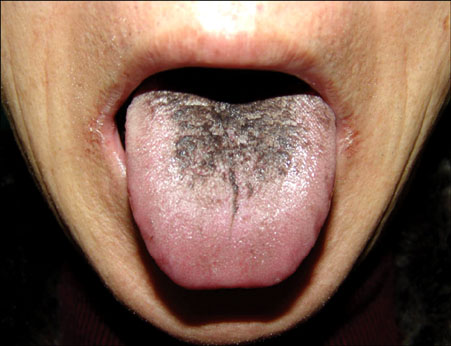Ann Dermatol.
2011 Nov;23(4):526-528.
Black Hairy Tongue Associated with Erlotinib Treatment in a Patient with Advanced Lung Cancer
- Affiliations
-
- 1Department of Dermatology, School of Medicine and Medical Research Institute, Chungbuk National University, Cheongju, Korea. tyyoon@chungbuk.ac.kr
- 2Department of Internal Medicine, School of Medicine and Medical Research Institute, Chungbuk National University, Cheongju, Korea.
Abstract
- Erlotinib is a tyrosine kinase inhibitor that acts on the epidermal growth factor receptor (EGFR). There have been many reports of the mucocutaneous side effects related to several EGFR inhibitors (EGFRIs). However, no case of black hairy tongue (BHT) associated with EGFRI has been reported. Herein, we report the first case of erlotinib-induced BHT in a 61-year-old man with advanced lung cancer. Considering recent use of EGFRIs worldwide, dermatologists should recognize the possible occurrence of BHT associated with EGFRIs such as erlotinib.
MeSH Terms
Figure
Reference
-
1. Marshall J. Clinical implications of the mechanism of epidermal growth factor receptor inhibitors. Cancer. 2006. 107:1207–1218.
Article2. Galimont-Collen AF, Vos LE, Lavrijsen AP, Ouwerkerk J, Gelderblom H. Classification and management of skin, hair, nail and mucosal side-effects of epidermal growth factor receptor (EGFR) inhibitors. Eur J Cancer. 2007. 43:845–851.
Article3. Thompson DF, Kessler TL. Drug-induced black hairy tongue. Pharmacotherapy. 2010. 30:585–593.
Article4. Manabe M, Lim HW, Winzer M, Loomis CA. Architectural organization of filiform papillae in normal and black hairy tongue epithelium: dissection of differentiation pathways in a complex human epithelium according to their patterns of keratin expression. Arch Dermatol. 1999. 135:177–181.5. Ettehadi P, Greaves MW, Wallach D, Aderka D, Camp RD. Elevated tumour necrosis factor-alpha (TNF-alpha) biological activity in psoriatic skin lesions. Clin Exp Immunol. 1994. 96:146–151.
Article6. Mössner R, Schön MP, Reich K. Tumor necrosis factor antagonists in the therapy of psoriasis. Clin Dermatol. 2008. 26:486–502.
Article7. Iwasaki S, Aoyagi H, Yoshizawa H. Immunohistochemical detection of epidermal growth factor and epidermal growth factor receptor in the lingual mucosa of rats during the morphogenesis of filiform papillae. Acta Histochem. 2007. 109:37–44.
Article8. Sakai Y, Nelson KG, Snedeker S, Bossert NL, Walker MP, McLachlan J, et al. Expression of epidermal growth factor in suprabasal cells of stratified squamous epithelia: implications for a role in differentiation. Cell Growth Differ. 1994. 5:527–535.9. Lee HH, Song IH, Friedrich M, Gauliard A, Detert J, Röwert J, et al. Cutaneous side-effects in patients with rheumatic diseases during application of tumour necrosis factor-alpha antagonists. Br J Dermatol. 2007. 156:486–491.
Article


